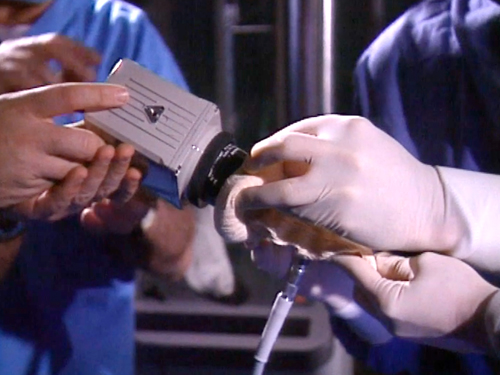
Using laparoscopic instruments equipped with a camera Jocelyne Saab films the in vitro fertilization process as it takes place. Report on implant operations in a hospital.
“Olivier Hadouchi: How did your career as a filmmaker begin?
Jocelyne Saab: Actually, I didn’t study film, nor did I follow the classic path of a filmmaker. In my family, in the society of the time and the milieu I lived in, film wasn’t considered a serious endeavour, unlike law or economics, for example. So I agreed to study economics, knowing that it was a way of buying time, until I was ready to follow my own path and go into journalism and film.
What were your first films? They were film reports, weren’t they?
Indeed, I began by making film reports, documentaries, and I didn’t come to fiction until much later. The boundaries between the two aren’t very clear-cut, however, and there are often documentary elements in fiction films and vice versa. At the time, there was a fabulous reporting tradition, with film crews in conflict zones that didn’t hesitate to take risks and demonstrate a certain situation by bringing us the footage. Resorting to cinema, especially to documentaries, in order to provoke or accompany social change, to denounce or to provide a basis for action, all this was very much present when I started.”
Olivier Hadouchi in conversation with Jocelyne Saab1
“En effet, si, comme le note Nicole Brenez, « le cinéma vise rarement la vie, il prétend plus souvent à l’intelligence des phénomènes qui soudent ou fracturent les communautés humaines », le caractère significatif du cinéma de Jocelyne Saab est cela même qu’il prétend à la vie. Le corps possède un langage et produit du sens. La cinéaste lui accorde toute son attention, dans toutes ses dimensions ; elle analyse même sa création depuis son origine, avec son documentaire Fécondation in video.
Ce documentaire met à profit les nouvelles technologies développées dans les années 1990 pour filmer un utérus de l’intérieur. Ce qui sera le nid d’une vie à venir est exposé à l’écran, donnant du corps une vision rare : il ne s’agit plus d’en délimiter les contours, la structure, de s’attarder sur sa chair ; dans un milieu presque aquatique où se développera l’embryon placé artificiellement en son sein, le matériau corporel apparaît à la fois visqueux et chaleureux, bien que fragile. La caméra s’avance jusqu’au cœur, à un millimètre de sa paroi : c’est dans ce milieu accueillant que se déroule l’action principale du film, la fécondation in vitro qui peut créer la vie.”
Mathilde Rouxel2
- 1Olivier Hadouchi, “Documenting and Telling the Torments of the World”, Sabzian, April 2021.
- 2Mathilde Rouxel, “Jocelyne Saab : filmer la vie incarnée”, La Furia Umana nr. 7, December 2014.

